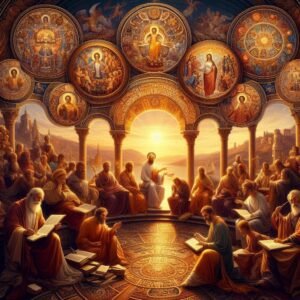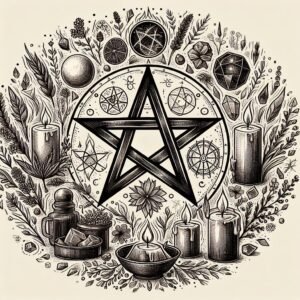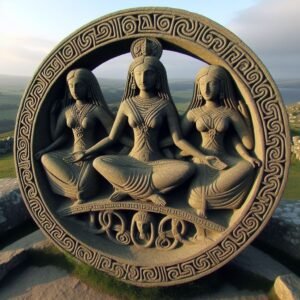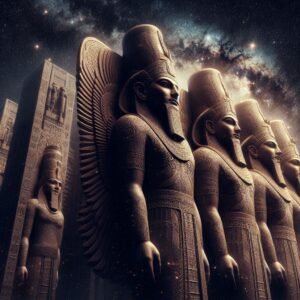
Throughout history, various figures and beliefs from pre-Christian traditions and early Christian sects have been omitted or marginalized in mainstream Christianity.
One such example is the Gnostic interpretation of figures like Sophia, a personification of wisdom, who plays a significant role in Gnostic texts but is not recognized in mainstream Christian doctrine.
The Gnostic interpretations
In Gnostic tradition, Sophia is a central figure, embodying wisdom and directly connected to the divine realm. Her story is a poignant example of the Gnostic narrative’s complexity and its divergence from mainstream Christian doctrine. Sophia, whose name means ‘wisdom’ in Greek, is considered one of the aeons, a divine entity born from the primordial parent and an integral part of the Pleroma, the fullness of the divine presence. Unlike the Christian interpretation of wisdom as an abstract quality or a gift from God, Gnosticism personifies wisdom in Sophia, attributing to her a narrative that explains the creation of the material world and the human condition.
Sophia’s tale is one of aspiration, error, and redemption. In her desire to create as she was created, Sophia acts independently without her male counterpart, leading to the birth of the Demiurge, a flawed entity who then crafts the material world. This world, according to Gnostic belief, is a lesser reflection of the Pleroma, trapping sparks of the divine within it. Sophia’s fall from grace is not just a personal failing but a cosmological event with profound implications for the universe and humanity. Her longing to return to the divine fullness results in the material world’s creation, where human souls are exiled, yearning for a return to the spiritual realm.
Sophia’s narrative also reflects a broader Gnostic theme: the distinction between the spiritual and material worlds. The material world, governed by the Demiurge, is seen as a place of ignorance and suffering, a stark contrast to the knowledge and enlightenment represented by the Pleroma. Sophia, in her flawed state, embodies this duality, being both divine and trapped outside the divine fullness. Her story is a metaphor for the human condition, caught between the physical and the spiritual, seeking knowledge and redemption.
Moreover, Sophia’s role in Gnostic texts challenges the patriarchal structures prevalent in early Christian communities. As a feminine deity, she represents an alternative view of the divine, one that includes a balance of male and female principles. This aspect of Gnosticism was often at odds with the emerging orthodox Christian doctrine, which largely marginalized or outright rejected feminine representations of the divine.
The Gnostic interpretation of Sophia offers a rich, symbolic narrative that speaks to deep existential questions about the origin of evil, the purpose of life, and the nature of God. It provides a framework for understanding the human experience as a journey of spiritual awakening, guided by wisdom and a longing for reconnection with the divine. While mainstream Christianity did not incorporate Sophia’s story into its doctrine, her presence in Gnostic texts remains a powerful testament to the diversity of early Christian thought and the enduring quest for meaning in the face of the unknown.
Similarly, the figure of Simon Magus, considered by some early Christian sects as a significant prophet, was later depicted as a sorcerer and heretic in orthodox Christian texts.
Simon Magus, a figure of considerable controversy in early Christian history, presents a fascinating study in the evolution of a religious character. Initially regarded by some early Christian sects as a significant prophet, Simon’s portrayal underwent a dramatic transformation in orthodox Christian texts. This Samaritan magus, or religious figure, is first mentioned in the Acts of the Apostles, where he is described as a sorcerer who bewitched the people of Samaria, claiming divine power. This account sets the stage for his later depiction as a heretic, a portrayal that has been shaped and reshaped by various Christian writers over time.
The early Christian apologist Justin Martyr, a native of Samaria himself, wrote that many Samaritans in his time were followers of Simon of Gitta, suggesting that Simon had a substantial influence during his lifetime. Irenaeus, another early Christian writer, believed Simon to be the founder of the sect known as the Simonians, further indicating his impact on early Christian thought. However, these accounts are not universally accepted as verifiable historical records, and some modern scholars dispute the claims that Simon was a Gnostic, suggesting instead that he was labelled as such by later Church Fathers.
In orthodox Christian texts, Simon’s narrative is expanded upon, with detailed accounts of his confrontations with the apostles, particularly Peter. The Acts of Peter, an apocryphal text, describe Simon as a formidable sorcerer capable of levitation and flight, which only added to his infamy within the Christian tradition. The Clementine literature, a collection of early Christian writings, contains quasi-Trinitarian Gnostic teachings attributed to Simon, wherein he is said to have appeared to the Jews as a suffering “Son of God,” to the Samaritans as “Father,” and to the pagan world as “Holy Spirit”.
The transformation of Simon Magus from a prophet to a heretic in Christian texts reflects the broader dynamics of heresy and orthodoxy in the early Church. As Christianity established its doctrinal boundaries, figures like Simon were often recast as antagonists to the emerging orthodox narrative. This process served not only to define what was heretical but also to solidify the authority of the orthodox position by providing a clear contrast between accepted beliefs and those deemed heretical.
Simon Magus’ legacy is a testament to the complex interplay between history, theology, and the construction of religious identity. His story, as it has been preserved in various texts, offers a window into the struggles of the early Christian community to define itself against competing interpretations of the faith. It also illustrates how figures from the past can be reinterpreted and repurposed to serve the needs of a developing religious tradition. The enduring fascination with Simon Magus lies in his dual role as both a historical figure and a symbol of the dangers of heresy, as perceived by the early Church.
Arius, a presbyter in Alexandria, Egypt, became a pivotal figure in early Christianity due to his controversial views on the nature of Christ, which sparked the Arian controversy. This theological dispute centred on whether Jesus Christ was of the same substance as God the Father or a separate, created being. Arius posited that Christ, while divine, was not co-eternal with the Father, suggesting a hierarchy within the Trinity. This stance was in direct opposition to the concept of consubstantiality championed by Athanasius, another prominent theologian of the time. The debate over these divergent views culminated in the First Council of Nicaea in 325, convened by Emperor Constantine. The council ultimately denounced Arius’s teachings as heretical, affirming the Nicene Creed, which declared the Son as “begotten, not made, being of one substance with the Father.” This creed became a cornerstone of orthodox Christian doctrine, shaping the Church’s understanding of the Trinity.
The Arian controversy did not end with the council’s decision. It continued to cause divisions within the Church for over half a century, influencing ecclesiastical politics and the alignment of various factions. The controversy persisted through subsequent councils and imperial decrees until the First Council of Constantinople in 381, which reaffirmed the Nicene Creed and further marginalized Arianism within the empire. However, Arianism found a foothold outside the Roman Empire’s borders, particularly among the Germanic tribes, and continued to be a significant theological current for centuries.
Marcion of Sinope, another influential figure in early Christian history, proposed a radical reinterpretation of Christianity. He drew a sharp distinction between the God of the Old Testament, whom he viewed as a lesser deity concerned with law and justice, and the God of the New Testament, a God of love and mercy revealed through Jesus Christ. Marcion’s teachings led to the formation of Marcionism, a sect that rejected the Old Testament entirely and promoted a version of Christianity that was in stark contrast to the proto-orthodox Christian beliefs of the time. His canon, which excluded the Old Testament and included an edited version of the Gospel of Luke and ten Pauline epistles, challenged the emerging orthodox Christian canon and forced the early Church to more clearly define its scriptures.
Marcion’s views were deemed heretical, and he was excommunicated from the Church in 144. Despite this, Marcionism gained a considerable following and became a widespread movement. The controversy surrounding Marcion’s teachings and his canon played a crucial role in the development of the New Testament canon and the formulation of Christian doctrine, as the Church sought to establish a clear boundary between orthodoxy and heresy.
Both Arius and Marcion left indelible marks on the history of Christianity. Their teachings, though ultimately rejected by the mainstream Church, prompted significant theological debates that shaped the development of Christian doctrine and the formation of the New Testament canon. These controversies highlight the diversity of early Christian thought and the complex process by which the boundaries of orthodoxy were drawn in the formative years of the Church.
The demonisation of local deities
Additionally, many local deities and religious figures from the polytheistic religions that Christianity encountered as it spread were either omitted or demonized in Christian tradition. For instance, pagan gods and goddesses were often reinterpreted as demons or were replaced by Christian saints in the process of syncretism.
The historical encounter between Christianity and the indigenous polytheistic religions of England is a complex tapestry woven with cultural, religious, and political threads. As Christianity spread across England, it encountered a rich tapestry of local deities and religious practices inherent to the Anglo-Saxon paganism that dominated the spiritual landscape from the 5th to the 8th centuries AD. This period, known as the Early Medieval England, was marked by a diverse array of beliefs and cultic practices, with significant regional variations. The Anglo-Saxon pantheon included prominent deities such as Woden, Thunor, and Tiw, alongside a host of other supernatural entities like elves and dragons that inhabited the landscape.
The process of Christianization often involved the reinterpretation of these pagan gods and goddesses; some were demonized, recast as malevolent figures in the new Christian narrative, while others were supplanted by Christian saints in a process known as syncretism. This was not merely a theological transformation but also a socio-political one, as the new religion brought with it new structures of power and social organization. The conversion to Christianity was a gradual and often contested process, with many pagan practices persisting in the form of folklore and local customs, subtly blending into the fabric of Christian tradition.
The term ‘paganism’ itself, along with ‘heathenism’, was a pejorative label applied by the Christianized Anglo-Saxons to the indigenous faiths. It is noteworthy that the followers of these pre-Christian religions did not have a specific name for their spiritual practices, which has led to debates among contemporary scholars about the appropriateness of these terms. Our understanding of Anglo-Saxon paganism is primarily derived from textual evidence produced by Christian Anglo-Saxons, place-name evidence, and archaeological findings, which provide insights into the cultic practices such as sacrifices and the celebration of religious festivals.
In modern times, there has been a resurgence of interest in these ancient belief systems, with movements like Wicca, Druidry, and Heathenry representing modern paganism in the United Kingdom. The 2021 UK Census recorded 74,631 individuals identifying as Pagans or members of specific modern Pagan groups, highlighting a growing trend towards these ancient spiritual paths. This revival is often characterized by a focus on nature, spirituality, and the celebration of the seasons, drawing inspiration from the pre-Christian traditions of the British Isles.
The formation of the Christian biblical canon
In addition, the formation of the Christian biblical canon was a complex and multifaceted process that unfolded over several centuries. It involved the discernment and selection of texts that were deemed authoritative and reflective of the core beliefs and practices of the early Christian communities. This process was influenced by various factors, including theological debates, ecclesiastical authority, and the practical needs of worship and instruction.
As the early Church sought to define its identity and beliefs, it became necessary to establish a set of writings that would serve as a normative guide for faith and practice. The texts that were eventually included in the canon, such as the four Gospels, the Acts of the Apostles, the Pauline Epistles, and the Book of Revelation, were recognized for their apostolic origin or connection, their widespread use in liturgy, and their consistency with the rule of faith.
Conversely, numerous other writings, now known as the apocrypha or pseudepigrapha, were excluded from the canon. These texts, which include the Gospel of Thomas, the Gospel of Mary, and the Acts of Peter, presented teachings, narratives, and figures that diverged from the emerging orthodox Christian narrative.
The Gospel of Thomas
For instance, the Gospel of Thomas, a collection of sayings attributed to Jesus, is characterized by a strong Gnostic influence, emphasizing esoteric knowledge and an inner spiritual revelation rather than the incarnational theology and historical resurrection emphasized in the canonical Gospels.
The Gospel of Thomas, often associated with Gnostic Christianity, presents a distinct perspective on the teachings of Jesus. Unlike the canonical Gospels, which focus on the narrative of Jesus’ life, death, and resurrection, the Gospel of Thomas comprises 114 sayings attributed to Jesus, emphasizing the pursuit of esoteric wisdom and spiritual enlightenment. This collection suggests that salvation is attainable through an inner awakening to divine knowledge, or gnosis, rather than through the traditional Christian doctrines of faith in the incarnation and physical resurrection of Jesus. The text portrays a version of Christianity that diverges significantly from mainstream traditions, aligning more closely with the mystical and individualistic aspects of spirituality that resonate with certain contemporary seekers.
The concept of gnosis is central to the Gospel of Thomas, where it is portrayed as a transformative realization of one’s true spiritual nature and the nature of reality. This form of knowledge is considered to be beyond the grasp of ordinary intellectual understanding, requiring a personal and profound revelation. The sayings within the Gospel often appear cryptic or paradoxical, designed to challenge the reader to move beyond literal interpretations and to engage with the teachings at a deeper, more intuitive level. The text suggests that this path of spiritual discovery leads to a unity with the divine, echoing the notion that individuals can become ‘twins’ of Christ, mirroring his spiritual enlightenment.
The Gospel of Thomas also diverges from the eschatological focus prevalent in early Christianity, which awaited the imminent Second Coming of Christ and the establishment of God’s Kingdom. Instead, it presents the Kingdom as a present reality, accessible through spiritual insight and self-knowledge. This reinterpretation of Christian eschatology reflects a broader Gnostic disdain for the material world and a focus on the spiritual realm as the true reality.
Scholarly debates continue regarding the origins and influences of the Gospel of Thomas. Some scholars argue that it contains some of the earliest recorded sayings of Jesus, possibly predating the canonical Gospels. Others, however, view it as a later compilation influenced by various sources, including early Christian, Jewish, and Hellenistic thought. The discovery of the Gospel of Thomas among the Nag Hammadi texts in 1945 has provided valuable insights into the diversity of early Christian beliefs and practices, highlighting the rich tapestry of interpretations that existed alongside the developing orthodox tradition.
In summary, the Gospel of Thomas represents a significant departure from the theological emphases of the canonical Gospels. Its focus on inner revelation and spiritual knowledge offers a different path to understanding Jesus’ teachings, one that has intrigued and inspired generations of readers and continues to be a subject of lively scholarly discussion and debate. The Gospel’s unique approach to Christian spirituality underscores the complexity and plurality of early Christian thought, inviting modern readers to explore the depths of its enigmatic wisdom.
The Gospel of Mary
The Gospel of Mary, attributed to Mary Magdalene, offers a portrayal of Mary as a prominent disciple and conveys a message that challenges the male-dominated leadership of the early Church.
The Gospel of Mary emphasizes the importance of inner spiritual knowledge and the concept of salvation through self-discovery and the pursuit of truth. The text suggests that the soul is eternal and that it undergoes a transformative journey after death, encountering various powers that challenge its progress towards eternal life.
In this gospel, Jesus imparts special teachings to Mary Magdalene, who then plays a pivotal role in encouraging the apostles to continue preaching after Jesus’ departure.
The text also explores themes such as the nature of sin and the human condition, portraying a vision of a genderless God referred to as “the Good.”
The Gospel of Mary challenges traditional views by suggesting that salvation and divine knowledge are accessible internally rather than through external rituals and institutions. It is a significant work that contributes to our understanding of early Christian diversity and the role of women in the early church.
The Gospel of Mary portrays a direct, personal experience of God, referred to as “the Good,” and dismisses the concept of sin as a product of fear.
Mary Magdalene emerges as a pivotal figure, representing a source of spiritual authority and insight. Her significance in this text is multifaceted: she is depicted not only as a close confidant of Jesus but also as a spiritual teacher in her own right. The gospel portrays her as understanding Jesus’ teachings more deeply than the other disciples, which is evidenced by her ability to comfort and lead them after Jesus’ departure. This portrayal challenges the traditional patriarchal structure of the early church by presenting a woman as an enlightened and leading figure within the Christian community.
Mary’s role in the Gospel of Mary is emblematic of the text’s broader themes, which include a critique of materialism and an emphasis on direct, personal experience of the divine. Her prominence in the gospel underscores the potential for leadership and spiritual authority regardless of gender, suggesting a more inclusive view of who can attain and impart spiritual knowledge.
The Acts of Peter
Similarly, the Acts of Peter presents a series of legendary and miraculous stories about the Apostle Peter that often conflict with the accounts found in the canonical Acts of the Apostles.
The Acts of Peter, an apocryphal text from the late 2nd century, diverge significantly from the canonical Acts of the Apostles with its collection of extraordinary narratives centred around the Apostle Peter. Unlike the canonical Acts, which detail the establishment of the Christian Church and its expansion throughout the Roman Empire, the Acts of Peter focuses on a series of miraculous events and confrontations between Peter and figures like Simon Magus, a magician who challenges the apostolic authority.
The text is renowned for its vivid portrayal of a miracle contest where Peter’s divine-backed powers triumph over Simon’s sorcery, reinforcing the apostle’s sanctity and the supremacy of Christian miracles over pagan magic. This apocryphal work also provides the earliest account of Peter’s inverted crucifixion, a symbol of his humility and unworthiness to die in the same manner as Jesus Christ. The Acts of Peter thus serves as a testament to the apostle’s steadfast faith and his role in the early Christian narrative, offering insights into the beliefs and traditions of early Christian communities that revered Peter as a pivotal figure.
he legendary elements within the Acts of Peter, while conflicting with the canonical texts, reflect the diverse ways in which the apostolic stories were remembered and celebrated, contributing to the rich tapestry of Christian tradition and hagiography. The canonical Acts of the Apostles, attributed to Luke the Evangelist, presents a more historical and theological account of the early church’s development, emphasizing the spread of Christianity and the Holy Spirit’s guidance in the apostolic mission.
It narrates the foundational events such as the Pentecost, the establishment of the church in Jerusalem, and the missionary journeys of Paul the Apostle, who becomes a central figure in the latter part of the text. The canonical Acts serves as a bridge between the Gospels and the Epistles, providing context for the latter’s teachings and the former’s narrative of Jesus’ life and ministry. It seeks to address the theological question of how the Messiah, expected by the Jews, came to have a predominantly Gentile church, suggesting that the Gentiles were included because the Jews, as a whole, did not accept the message of Christ.
In contrast, the Acts of Peter, with its apocryphal status, does not hold the same canonical authority but offers a glimpse into the variegated landscape of early Christian literature, where the miraculous and the legendary played a significant role in shaping the identity and piety of Christian communities. These texts collectively underscore the multifaceted nature of early Christian storytelling, where history, theology, and legend intertwine to articulate the faith’s foundational narratives and the apostles’ exemplary lives.
The criteria for inclusion in the canon were not solely based on content but also on the perceived authenticity and apostolicity of the texts. Works that were considered pseudepigraphal, meaning they were falsely attributed to apostolic figures, were generally not accepted into the canon. The process of canonization was gradual and not without controversy, as different Christian communities held varying views on certain texts. It was not until several Church councils, such as the Councils of Hippo (393 AD) and Carthage (397 AD), that a more definitive list of canonical books began to take shape.
The establishment of the canon had significant implications for the development of Christian doctrine and the exclusion of certain texts played a role in shaping the boundaries of orthodoxy. It also influenced the way Christians understood the nature of revelation, authority, and the relationship between scripture and tradition. The apocryphal and pseudepigraphal texts, while not included in the canon, continue to be of interest to scholars and believers alike for the alternative perspectives they offer on early Christian thought and practice.









Truth of Self › Forums › Characters and texts omitted by the Christian belief
Tagged: acts of peter, christianity, deities, gnostic, gospel of mary, gospel of thomas, pagan, paganism